
views
Converting Fahrenheit to Celsius

Understand the scales. The Fahrenheit and Celsius scales begin at a different number—where 0° Celsius is freezing, that equivalent temperature in Fahrenheit is 32°. In addition to starting at a different temperature, the two scales rise at different rates as well. For instance, the range from freezing to boiling in degrees Celsius is 0-100°, and the same range in degrees Fahrenheit is 32-212°.
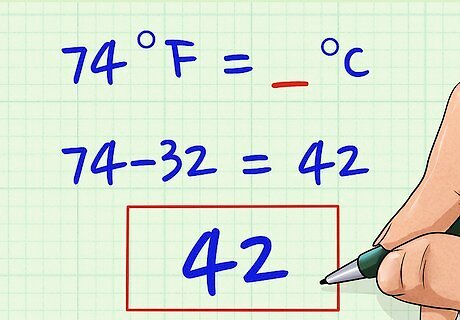
Subtract 32 from the Fahrenheit temperature. Since freezing for Fahrenheit is 32 and freezing for Celsius is 0, you begin the conversion by subtracting 32 from the Fahrenheit temperature. For example, if your initial Fahrenheit temperature is 74°F, just subtract 32 from 74. 74-32 = 42.
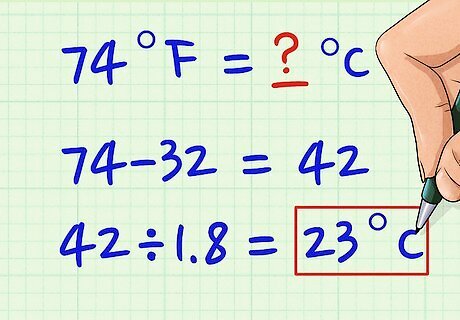
Divide the result by 1.8. The range for freezing to boiling in Celsius is 0-100 whereas it's 32-212 in Fahrenheit. This is the same as saying that for every 180° Fahrenheit range, there is only a 100° Celsius range. You can express that as 180/100, which when simplified equals 1.8, so to finish the conversion you must divide by 1.8. For the example from step one, divide your result, 42, by 1.8. 42/1.8 = 23°C. Therefore, 74°F can be converted to 23°C. Note that 1.8 is the equivalent of 9/5. If you don't have a calculator or prefer working with fractions, you can divide your result from the first step by 9/5 instead of 1.8.
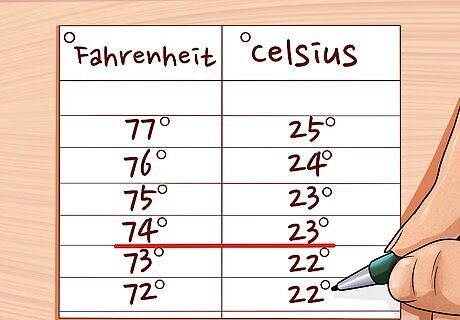
Check your answer. Here are a few conversions so you can see whether your result makes sense. If you get a result that doesn't fit this scale, check your math again. You may have forgot to subtract before dividing. ºFahrenheit ºCelsius (approx) -40 -40 0 -18 32 0 60 16 100 38 150 66 212 100
Converting Celsius to Fahrenheit
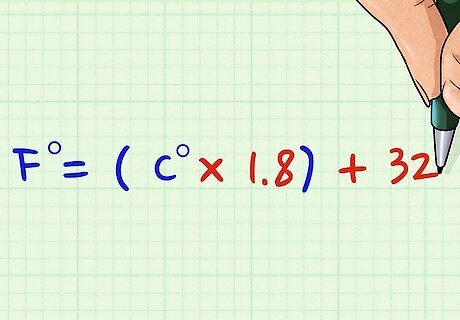
Understand the scales. Since the same rules in the scale differences apply when converting Celsius to Fahrenheit as the opposite, you'll still be using the difference of 32 and the scale difference of 1.8. You just use them in the reverse order.
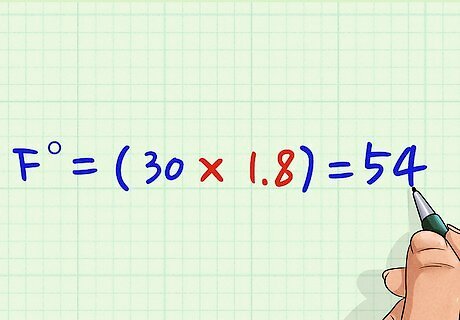
Multiply the Celsius temperature by 1.8. If instead, you want to convert the temperature from degrees Celsius to degrees Fahrenheit, you can simply reverse the process. Begin by multiplying the Celsius temperature by 1.8.
Work with a 30°C temperature. For example, if you're working with the temperature 30°C, you should first multiply it by 1.8, or 9/5. 30 x 1.8 = 54.
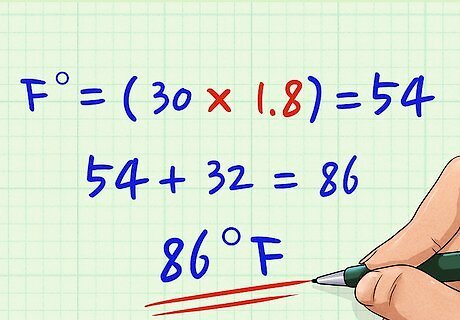
Add 32 to the result. Now that you have corrected for the differences in scale, you still must correct for the difference in starting points as in step one. To do this, add 32 to the Celsius x 1.8 temperature, and you will have the final temperature in degrees Fahrenheit. Add 32 to 54, which was the result from step 3. 54 + 32 = 86°F. Therefore, 30°C is equivalent to 86°F.
Check your answer. If your answer doesn't fit between two lines of this chart, you've probably made a math error. Remember to multiply by 1.8 before adding 32. ºCelsius ºFahrenheit -40 -40 0 32 15 59 30 86 60 140 100 212 200 392
Make a general comparison. A more general way to compare the two is to realize that every 5°C equals 9°F: ºCelsius ºFahrenheit ºCelsius ºFahrenheit -50 -58 0 32 -45 -49 5 41 -40 -40 10 50 -35 -31 15 59 -30 -22 20 68 -25 -13 25 77 -20 -4 30 86 -15 5 35 95 -10 14 40 104 -5 23 45 113 50 122
Understand the conversion. Given the 1.8 conversion factor, each 1°C difference equals 1.8°F, with that idea highlighted in the 10-15°C range: ºCelsius ºFahrenheit ºCelsius ºFahrenheit -1 30.2 10 50.0 0 32.0 11 51.8 1 33.8 12 53.6 2 35.6 13 55.4 3 37.4 14 57.2 4 39.2 15 59.0 5 41.0 16 60.8 6 42.8 17 62.6 7 44.6 18 64.4 8 46.4 19 66.2 9 48.2 20 68.0
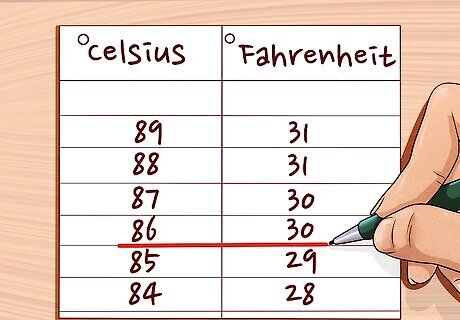
Round the values to a whole number. If one rounds the Fahrenheit values, the difference in Fahrenheit from the nearest 5 or 10°C has the pattern 2,4,5,7: ºCelsius ºFahrenheit (rounded) 5 41 = 41+0 = 41-0 6 43 = 41+2 = 50-7 7 45 = 41+4 = 50-5 8 46 = 41+5 = 50-4 9 48 = 41+7 = 50-2 10 50 = 50+0 = 50-0 11 52 = 50+2 = 59-7 12 54 = 50+4 = 59-5 13 55 = 50+5 = 59-4 14 57 = 50+7 = 59-2 15 59 = 59+0 = 59-0
Converting Celsius to Kelvin

Understand the scales. Scientists understand the Celsius scale as derived from the Kelvin scale. Though the gaps between Celsius and Kelvin are even larger than the gaps between Celsius and Fahrenheit, one thing that Celsius and Kelvin have in common is that they rise at the same rate. Whereas the ratio for Celsius to Fahrenheit is 1:1.8, the ratio for Celsius to Kelvin is 1:1. If it seems odd that freezing for Kelvin would be such a high number — 273.15 — it's because the Kelvin scale is based around absolute zero, which is 0K.
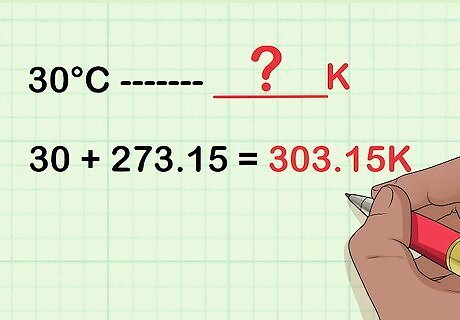
Add 273.15 to your Celsius temperature. Though 0°C is the freezing temperature of water, scientists actually understand 0°C as 273.15K. Since the two scales rise at the same rate, then converting Celsius to Kelvin always means simply adding 273.15. For example, if you're working with the temperature 30°C, just add 273.15 to that. 30 + 273.15 = 303.15K.
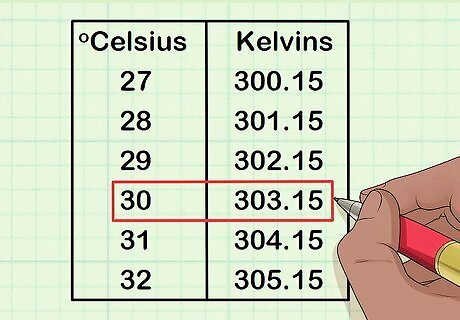
Check your answer. Here's a rough scale so you can test whether your answer makes sense. Note that the Celsius and Kelvin scales increase at the same rate, so the two numbers are always exactly 273.15 apart. If you start with an integer value of degrees Celsius, your result in kelvins will end in the decimal .15. The lowest possible temperature is -273.15ºC = 0 kelvins. If your result involves negative kelvins, you either made a math mistake or the problem uses impossible values. ºCelsius kelvins -100 173.15 -50 223.15 0 273.15 50 323.15 100 373.15 200 473.15 500 773.15
Converting Kelvin to Celsius
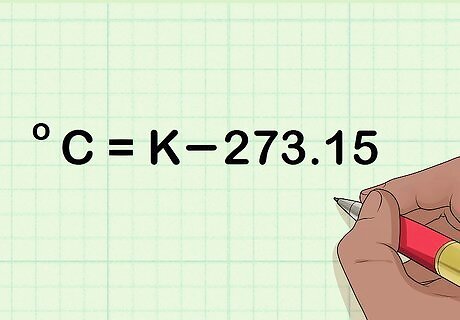
Understand the scales. The 1:1 ratio for each degree Celsius and Kelvin still applies while converting Kelvin to Celsius. You mostly need to remember the 273.15 number and perform the opposite operation as when you convert Celsius to Kelvin.

Subtract 273.15 from your Kelvin temperature. If instead you need to convert the temperature from Kelvin to Celsius, you can simply reverse the operation and subtract 273.15. Let’s say you're starting with a Kelvin temperature of 280K. Just subtract 273.15 from 280 to get the Celsius temperature. 280K - 273.15 = 6.85°C.
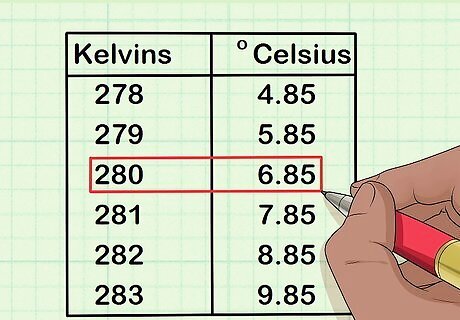
Check your answer. If the two values you have don't fit the pattern described in this table, check for math mistakes. If you start with an integer value of kelvins, your result in degrees Celsius will end in the decimal .15 (if Celsius is negative) or .85 (if Celsius is positive). Note how the difference between kelvins and Celsius becomes less important for very large numbers. Once you're dealing with 6+ digits, the difference is often within your margin of error. kelvins ºCelsius 0 -273.15 5 -268.15 50 -223.15 200 -73.15 500 226.85 1,000 726.85 100,000 approx. 99,700 10 million very close to 10 million
Converting Kelvin to Fahrenheit
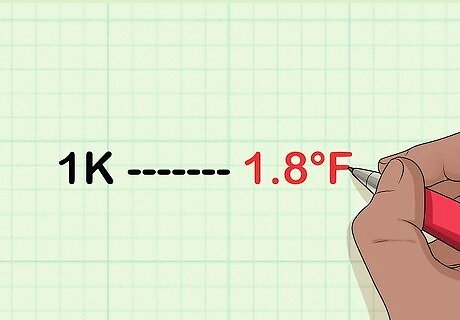
Understand the scales. One of the most important things to remember while converting between Kelvin and Fahrenheit is the rise ratio. Since Kelvin has a 1:1 ratio with Celsius, it has the same ratio to Fahrenheit as Celsius, which is to say that for every 1K, Fahrenheit changes by 1.8°F.
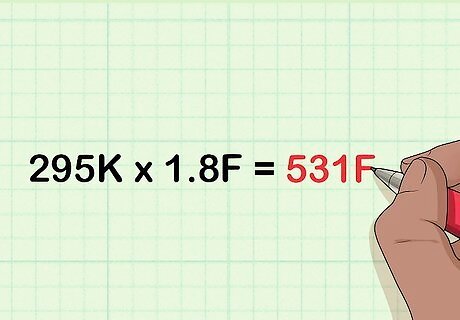
Multiply by 1.8. In order to correct for the 1K:1.8F scale, the first step in converting Kelvin to Fahrenheit is multiplying by 1.8. Let’s say you're starting with a temperature of 295K. Just multiply that number by 1.8. 295 x 1.8 = 531.
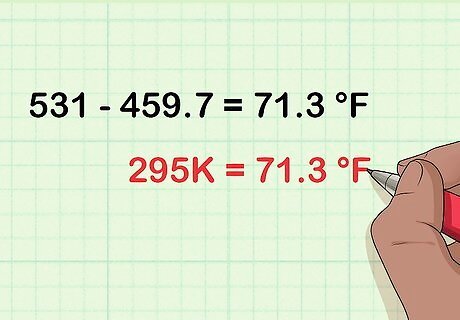
Subtract 459.7 from the result. Just as we must correct for the starting point of the scale by adding 32 when converting Celsius to Fahrenheit, we must also do the same when converting Kelvin to Fahrenheit. However, 0K = -459.7°F. Since the number we have to add is actually a negative number, that means we must simply subtract the number. Just subtract 459.7 from 531. 531 - 459.7 = 71.3 °F. Therefore, 295K = 71.3 °F.
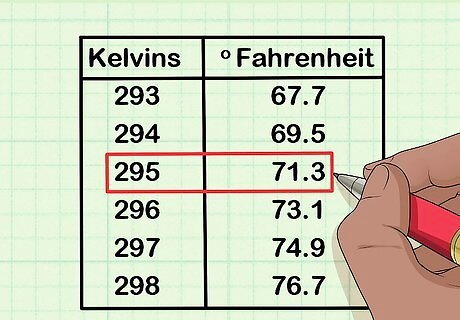
Check your answer. If your conversion doesn't fit between two lines of this table, try again. You may have made a math mistake, or forgotten to multiply before subtracting. If you start with an integer value of kelvins, your answer in degrees Fahrenheit will end in the decimal .67 (if ºF is negative) or .33 (if ºF is positive). kelvins ºFahrenheit 0 -459.67 5 -450.67 50 -369.67 200 -99.67 500 440.33 1,000 1,340.33 100,000 approx 180,000.
Converting Fahrenheit to Kelvin
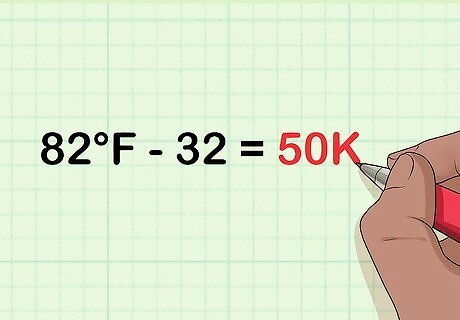
Subtract 32 from the Fahrenheit temperature. On the other hand, to convert a Fahrenheit temperature to a Kelvin temperature, it’s easiest to convert to Celsius and then make the conversion to Kelvin from there. This means we begin by subtracting 32. Let’s say the temperature is 82°F. Subtract 32 from that number. 82 - 32 = 50.

Multiply that number by 5/9. When converting Fahrenheit to Celsius, the next step is to multiply by 5/9–or divide by 1.8 if you have a calculator around. 50 x 5/9 = 27.7, which is the Fahrenheit temperature now converted to Celsius.

Add 273.15 to this number. Since the difference between Celsius and Kelvin = 273.15, you can then get the Kelvin temperature by adding 273.15. 273.15 + 27.7 = 300.8. Therefore, 82°F = 300.8K.

Check your answer. Compare your result to this table to see if it makes sense. If it doesn't seem to fit the scale, try again. Make sure you subtract before multiplying. ºFahrenheit kelvins (approx) -25 241 0 255 32 273.15 exactly 70 294 100 311 150 339 212 373.15 exactly




















Comments
0 comment